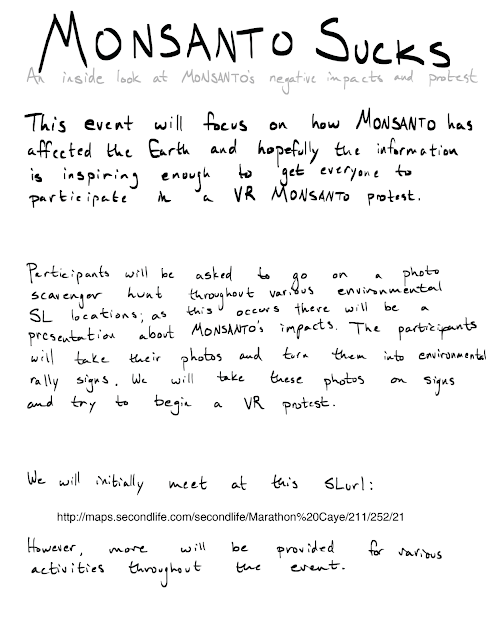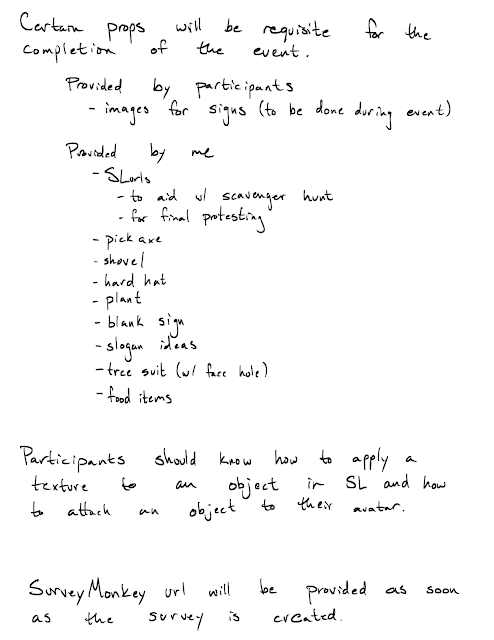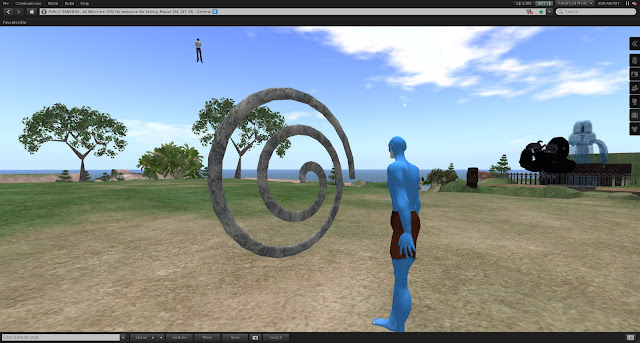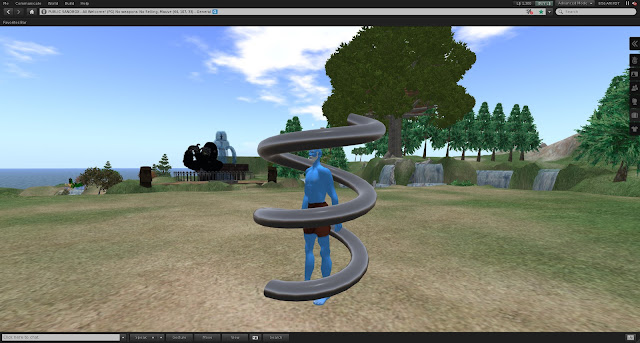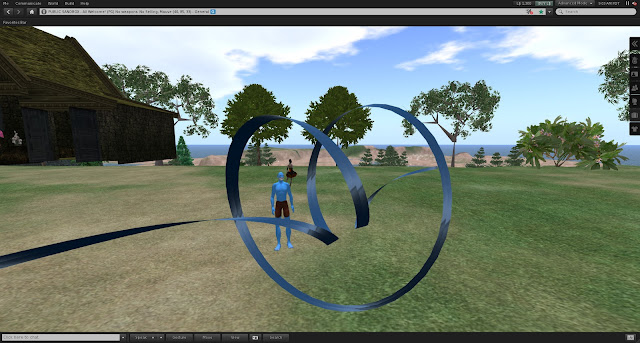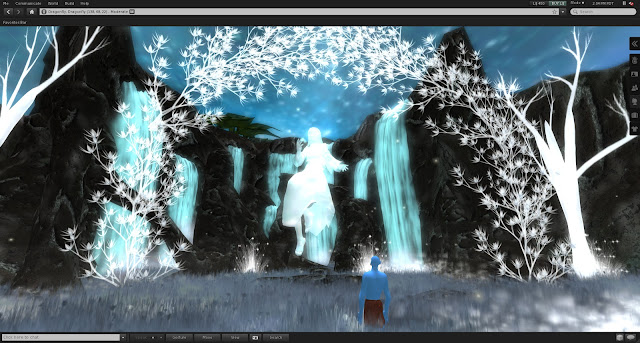627NickD
Friday, December 16, 2011
Concept Proposal
Concept Design Proposal Document + Presentation
- Title
- ThirdEye
- The Big Idea – your concept summarized in 5 words.
- Use Augmented Reality to transform the real world into a virtual world
- Target member – who is your core customer and WHY? How much time to spend? Technical limitations to their computer and internet connection?
- Young adults with interest in social networking as well as video games. Users, I imagine, could enter this world whenever they so choose by applying an AR skin over what they see when they leave the house. This could be for a few minutes or several hours. The users’ computers would need to have a camera, GPS, and compass built in and all of the computers must be able to recognize where the other users’ computers are when they are in the world. Object tracking is also a must. Because this is an AR world, it is easier to have mobile computers, laptops or smart-phones, do the hard work rather than lugging around a desktop. An optional hardware item, an AR visor, can be purchased and used to interface in the world rather than using a smart-phone or laptop.
- Value Proposition – what does your “target member” care about and need?
- The target member cares about making friends and enjoys the digital landscape. They would also have a desire to go out of the house, rather than be cooped up inside. Young adults want a way to communicate with others over the internet without needing to be stuck on a computer. They would like a more intimate connection with others, but this generation still loves technology.
- World Design Feature Categories (in outline format, describe each verbally in functional detail and use visual mockup examples where words fail):
- Self – Appearance, Expression, Communication, Connection to Others, Persona, Reputation, and Personal Abilities.
- Similarly to SecondLife, the user can make their avatar into anything. The only difference is that they will physically appear as that avatar in world. As the camera of User A detects User B, User B will appear as their avatar on User A’s screen. User A could then click on User B to bring up more information about User B and also a chat option. The expressions and movements of the avatars all relate to the movements and expressions of the user acting as that avatar. Special rewards, prizes, or icons could be given out in world to represent certain groups of people. Like on social networking sites, users can join groups. After joining a group, that user would receive an on-screen tag that indicates the other users in the group as they appear on-screen.
- Place – World Story, Navigation, Purpose, Ownership, Creativity and Expression, Impact. Verbal description and illustrate with visual design examples/mockups.
- The real world itself will become the basis for the virtual world. Users can pay to create and upload objects into the world. After doing so, the user attaches the object to an existing marker within the world. This could mean attaching it to the ground, a building, or any other non-mobile piece of the environment. Once an item has been attached it can be viewed by everyone, though the creator remains the owner of the object. Objects will remain permanently attached for one calendar year before being cleared away to make space for new creations. Creators have the option of clearing an object they created and attached at any time. Any uploaded objects are automatically saved into the user’s inventory for use wherever. Users navigate the space by moving their camera to change what they are viewing and can move their actual avatar by physically moving themselves. Any user can create a 2D or 3D object to insert into the landscape. They can also comment on others’ objects throughout the world.
- Purpose – Express, Connect, Create, Shop, Play, Explore, Learn, Socialize, Make Money, etc. Describe in detail - must relate very directly to the target.
- The purpose of this world is to connect people in the real world through augmented reality and an imposed virtual world. Users will be able to physically interact with other avatars in game, and therefore, in real life as well. It will also provide a convenient conversation starter; users can talk to each other through the world or in RL about avatars or cool objects that are in the area. Users are also welcome to create anything they can imagine in digital space and attach it to the environment for other to see. Creators could potentially earn money for their work when users want to take a copy for themselves. For a little in-game money, users can decorate the world with their favorite digital objects; objects purchased in this manner would only be viewable to the user that purchased the object.
- Fun Things To Do – Imagine, Games, Vehicles, Learn, Sports, Pets, Quests, Movies, Invent, etc. Verbal description and illustrate with visual design mockups.
- Users could have sort of digital geo-caching experience by travelling around to various parts of the world to see the many different created objects. Users, in theory, could create any sort of 2D, 3D, interactive, moving, or animated objects that would allow the users to choose how they would like to be entertained. Parks could be setup for an augmented reality medieval reenactment for a day. A user could play a movie on the side of a building so anyone could watch it. Anything that a user could potentially make in the digital world could become part of the augmented world.
- Society – Rules, Economy, Government, Judicial System, Safety System
- Before attaching publicly viewable objects, they would be approved by a moderator for decency. The objects would then be sorted by a maturity rating. Provocative images and objects could be displayed for those who are adults, while parental controls of some sort could be placed on anyone under a certain age. This would allow users to not be limited completely by restrictions while protecting the youth from disturbing or immoral images. There would be an in-world currency that users could use to pay to attach objects to the world. They could also purchase copies of their favorite objects for their own personal viewing pleasure.
- World Design Plan – Visual Designs (minimally detailed sketches, maximally finished prototype illustrations). Depending on your concept, provide map, at least two example location designs, diagram of locations and relations to each other, examples of building design, object design, general avatar look, etc.
- Interface Components – In-world and HUD Graphical User Interface (e.g. menus, etc). Text descriptions, sketches and/or prototype illustrations, sketches showing operation of GUI components, etc. For In-World applications, also provide detailed flow-charts showing how it works.
- Out-World Components – Identify, describe, and offer at least 2 sample design sketches for the Web-based companion-components to your virtual world, e.g. web site, member forum, member wiki, special interest groups, social event scheduling and notification, reputation-ranking, etc. How will all this be structured, accessed, and what is the look and feel of its overall design?
- Research – Include all background research you did in developing this concept design (Text and images). What other virtual worlds/games were examined and what lessons (inspirational, contrasting, negative examples) were learned from them? What readings and websites did you access and what did those contribute?
Thursday, November 3, 2011
Monsanto Sucks! Protest Review
So it was educational and a little boring, but I did it by myself and was ready to go for day one.
I was hoping to keep a moderately faster pace for the event, but many people had difficulties finding the right locations or had computer difficulties. But overall, I achieved my goal to communicate more about Monsanto.
Only 23.1% of the class knew about Monsanto’s practices before this event.
And only one person said they learned nothing from the event.
So the other 92.3% took something away from the event, Awesome!
Here is what some people learned:
“I learned about some instances of Monsanto's actions that I was not yet familiar with.”
“I was never really informed about this topic issue, so it was really interesting learning the dynamics socially, politically, and ethically involved with this corrupt corporation.”
“Probably the fact that the company is able to own techniques and even SEEDS. That corporations exploit workers, ruin the environment and falsify documents are not exactly rare secrets, but I have to admit, this is a new level of legal sleaze.”
“I felt it was very interesting learning about the mass suicides in India, as a result of the Monsanto plague that has been spreading all around the world. It's also crazy the punishment is greater in Tennessee of obtaining the seeds than having cocaine.”
While I tried to teach everyone something, there were a few concerning responses regarding what was learned:
“Not much”
“environmental issues”
“Protesting is everywhere.”
“monsanto is bad.”
Responses like these show a lack of interest in the topic. While my event was simplistic, it was intended to let each participant use their own will. Those who did not pay attention or do not care about what they eat (or where their food comes from) would be less interested.
I wanted participants to use their own brains to develop this protest more, but they were resistant to doing so. Most participants did not help communicate the reason for protesting when in SecondLife. I found that I was the only person really trying to talk more about Monsanto with people.
While I wish the locations for the protest I had chosen were more populated when we visited them, I guess we made do. When I originally went to visit those locations, they each had at least 10-30 people on them.
There also seemed to be difficulty following the class around from location to location. This could be easily rectified if the class all became friends on SecondLife. When friends, it allows you to invite people to teleport to your location.
One comment that I thought was particularly interesting said that my event was “funny free.” I’m sorry that my sarcasm is not as funny to the class as it is to me. I made several sarcastic jokes during my presentation, and no one laughed, so I figured the class wanted dull and dreary presentation time. The educational and professional feeling was only my reaction to my crowd.
Overall, I think I taught most people something about the harms of Monsanto and most people enjoyed the disruption that the protesting caused at the dance event. Hopefully, people will want to continue to learn more about Monsanto and prevent their growing destruction.
Here are some links to articles for more information:
Vote for California GMO Labeling Bill
Monsanto taking over dairy industry
News updates about Monsanto
So many issues to answer for
And these are some images from the protest event:
Sunday, October 23, 2011
SecondLife Event Plan
Monsanto Sucks Protest
Since its creation, Monsanto has produced toxic chemicals, such as Agent Orange and many pesticides, and genetically modified foods that do nothing but harm our global environment. There are even known cases against Monsanto that they deny. For example, Monsanto spent 40 years dumping toxic PCBs, an industrial coolant, in a creek in Anniston, AL. Even though they knew life could no longer survive in the creek, Monsanto provided altered documents that said their activities did not seem harmful. They still have not taken responsibility for this massive toxic waste dump. In addition to this dumping, Monsanto is guilty of creating some of the world’s most deadly chemicals used for pesticides, herbicides, and at one point they produced Agent Orange, an extremely controversial herbicidal weapon used during the Vietnam War. In addition to making toxic chemicals, Monsanto also makes genetically modified seeds that produce food that is not necessarily safe to eat. These seeds are resistant to Monsanto’s own herbicides. This forces farmers to rely on Monsanto every year for each new harvest season. Monsanto has taken over the agriculture industry, which is not good considering they are one of the largest producers of toxic chemicals in the world.
This event will focus on how Monsanto has affected the Earth. Hopefully the information will be inspiring enough to begin a small Anti-Monsanto protest in SecondLife.
Participants will be asked to go on a photo scavenger hunt throughout SecondLife to find various environmentally related landscapes; as this occurs there will be a presentation and Q&A about Monsanto’s affects and policies. The participants will take their photos and turn them into environmental rally signs, where they will be taken around various locations in SecondLife for a minor protest.
In order to prepare, participants are asked to have at least L$10 for upload. There is also an additional tree costume that you may purchase. While I will provide a free tree suit, if you would like a nicer sculpted tree costume there is one available for L$150 at the following SLurl. Buying the tree costume is not mandatory, but it looks way more tree-like than the one I made.
Nice tree costume (L$150)
We will initially meet at the following SLurl inside the towers of Arboretum (it should be where your avatar spawns):
Each participant must complete the following tasks during the event:
1. Go on a scavenger hunt through SecondLife where you will screen capture five environmentally/agriculture related images. Some examples are images of your avatar (or a friends) in a realistic forest, on a farm, doing VR environmental service, eating food, or some other idea. This list of SLurls should help you find appropriate locations more easily, but please feel free to explore new regions that are similar.
Forested Lands
Farm Lands
2. After creating the screen captures, use the images to create environmental/Anti-Monsanto protest signs. Use a photo-editing software to add slogans or additional effects to make your image more meaningful.
3. Meet inside SecondLife at the following SLurl to receive a free protest sign and tree suit.
3. Meet inside SecondLife at the following SLurl to receive a free protest sign and tree suit.
4. Upload your image to SecondLife and using the “Select Face” option in the object edit dialog box, apply your protest image to both sides of your sign.
5. Adorn your tree suit and adjust it if necessary.
6. As a group, we will then go to various environmentally forward SecondLife locations to hopefully spread information about Monsanto’s effect on the world.
Protest Locations
7. Email any images or screen captures to ndyer52@hotmail.com with the subject “DAI 627 – SL images”
For the scavenger hunt, participants can work individually or in small groups. Everyone is expected to take screen captures during the scavenger hunt. The protest will be documented by Professor Veeder and myself. I may need one additional person that is comfortable with the camera controls to document the protest.
I will provide certain props that can be used for the scavenger hunt (if you would like them) and for the protest.
· Pickaxe
· Shovel
· Blank Protest sign
· Tree suit
Participants will provide the images for the signs which shall be created during the event.
SurveyMonkey Survey url:
Sunday, October 16, 2011
Saturday, October 15, 2011
Interests and Skills in Relation to a SL Event
Personal interests that may be demonstrated in SecondLife
- Environmental awareness
- Fitness
- Gardening
- Guerrilla Art
SecondLife skills
- Prim building
- Basic modeling
- maybe UV mapping if I tried it
- Basic scripting
I think it may be interesting to do an event in regards to environmental awareness. It is an issue that I, along with many others, have strong opinions about. I would also like to teach some sort of lesson that participants can take with them into real life.
- Environmental awareness
- Fitness
- Gardening
- Guerrilla Art
SecondLife skills
- Prim building
- Basic modeling
- maybe UV mapping if I tried it
- Basic scripting
I think it may be interesting to do an event in regards to environmental awareness. It is an issue that I, along with many others, have strong opinions about. I would also like to teach some sort of lesson that participants can take with them into real life.
SecondLife: Understanding and Experimenting with Prims
My first prim. I used a .png file with an Alpha-Mask transparency as the texture. I learned that when you change the color of a (semi)transparent texture, the new color will replace the old colors.
Then I used the prim build and edit controls to make a portable party room. Various tools allow the builder to create virtually anything they could imagine (granted it will look like it's made of geometric prim shapes). The twist tool allows you to twist most prims along two different axes. It's also important to link your objects together as you go and use the "edit linked" check box. This will make it easier to save to your inventory later.
This here is a two piece easy spiral ramp. I used the twist and the path cut tool on a cylinder prim to make a double-helix ramp. I added a tube with a semi-transparent grate texture to act as a banister. Presto! Just walk up the tube and you can't fall out (not that it matters in a world where you can fly).
I used the hole cut tool to make an opening in a large, flat rectangular prim. I made the hole a circle so it fit nicely over the top of the spiral ramp. Add a nifty fog wall, a 50s style pitched roof, some benches, and you've got a perfect little outlook tower.
Or come meander aimlessly in this building. No need for support columns in virtual worlds! Why build something boring and realistic when physics are out the window?
But if you really want some columns, here are some cool ones you can make. Take a tube prim and mess around with the hole cut and the path begin/end tools. Combining these in different ways can give you all sorts of easy columns made from only a single prim.
I was able to combine various prims and tool functions in order to create a private outlook tower. I made the spiral ramp less steep so it would be easier to get up. But the cool part is once you are inside.
The walls are invisible from the inside. So everyone in the room can see outwards, but nobody can see in from the outside.
I found a few ways to manipulate prims by twisting them in weird enough ways to make familiar objects. An infinity symbol or an 8.
A spiral.
A metal spring.
A flat metal spring.
A strange knot.
Really there is a lot of potential for modeling objects with prims. If you have the patience to learn how to manipulate prims properly, the number and variation of objects you could make is limitless.
Then I used the prim build and edit controls to make a portable party room. Various tools allow the builder to create virtually anything they could imagine (granted it will look like it's made of geometric prim shapes). The twist tool allows you to twist most prims along two different axes. It's also important to link your objects together as you go and use the "edit linked" check box. This will make it easier to save to your inventory later.
This here is a two piece easy spiral ramp. I used the twist and the path cut tool on a cylinder prim to make a double-helix ramp. I added a tube with a semi-transparent grate texture to act as a banister. Presto! Just walk up the tube and you can't fall out (not that it matters in a world where you can fly).
I used the hole cut tool to make an opening in a large, flat rectangular prim. I made the hole a circle so it fit nicely over the top of the spiral ramp. Add a nifty fog wall, a 50s style pitched roof, some benches, and you've got a perfect little outlook tower.
Or come meander aimlessly in this building. No need for support columns in virtual worlds! Why build something boring and realistic when physics are out the window?
But if you really want some columns, here are some cool ones you can make. Take a tube prim and mess around with the hole cut and the path begin/end tools. Combining these in different ways can give you all sorts of easy columns made from only a single prim.
I was able to combine various prims and tool functions in order to create a private outlook tower. I made the spiral ramp less steep so it would be easier to get up. But the cool part is once you are inside.
The walls are invisible from the inside. So everyone in the room can see outwards, but nobody can see in from the outside.
I found a few ways to manipulate prims by twisting them in weird enough ways to make familiar objects. An infinity symbol or an 8.
A spiral.
A metal spring.
A flat metal spring.
A strange knot.
Really there is a lot of potential for modeling objects with prims. If you have the patience to learn how to manipulate prims properly, the number and variation of objects you could make is limitless.
Thursday, September 22, 2011
Navigation
I began exploring in the Grand Canyon by flying around. It was quite easy to do so and is much faster than walking or running. It'd be nice to be able to fly like this to work or wherever; we wouldn't need cars if we could.
At the bottom of the canyon I found a campfire and an alligator. I felt the Irwinian need to get closer.
I got too close!
Then I walked around Dragonfly and found some interesting places. Here is a glowing statue in an enchanted meadow of some sorts. It was very nice to look at visually.
I enjoyed the bright colored flowers that cover the grounds. Even the petals have little spot and striping details that make them even more realistic.
I found a dragon statue dedicated to someone whom I think is deceased. But that may be wrong, or it may be a SecondLife character. Either way, this statue is awesome.
I finally teleported to Whitsundays Oceania. There I found quite an array of sea creatures and places to explore.
I tried to ride on the dolphin but it wouldn't let me sit. Maybe a cool dolphin would be one you could do that with.
Great white sharks aren't so scary when you cannot be eaten. And even if I was, it wouldn't hurt a bit.
After drying off, I found a wedding chapel. I guess there is quite a demand for getting married in Second Life. Not my idea of romance, but kind of a cool extra if you have family that cannot make it to the real ceremony.
I finally relaxed on the beach under an umbrella with watermelon cooler. ahhh... refreshing.
At the bottom of the canyon I found a campfire and an alligator. I felt the Irwinian need to get closer.
I got too close!
Then I walked around Dragonfly and found some interesting places. Here is a glowing statue in an enchanted meadow of some sorts. It was very nice to look at visually.
I enjoyed the bright colored flowers that cover the grounds. Even the petals have little spot and striping details that make them even more realistic.
I found a dragon statue dedicated to someone whom I think is deceased. But that may be wrong, or it may be a SecondLife character. Either way, this statue is awesome.
I finally teleported to Whitsundays Oceania. There I found quite an array of sea creatures and places to explore.
I tried to ride on the dolphin but it wouldn't let me sit. Maybe a cool dolphin would be one you could do that with.
After drying off, I found a wedding chapel. I guess there is quite a demand for getting married in Second Life. Not my idea of romance, but kind of a cool extra if you have family that cannot make it to the real ceremony.
I finally relaxed on the beach under an umbrella with watermelon cooler. ahhh... refreshing.
Friday, September 9, 2011
Virtual Persona
My initial character is going to be a large blue warlock. I plan on making him a gentle but powerful giant. With no real goal in life, he will roam the lands in search of meaning. He will hopefully be a character people will remember seeing.
Most people were confused as to why I was being a warlock. People also noted from my lack of avatar manipulation the fact that I was new to the game. I found it difficult after a while to chat with other users as my character. I quickly found myself just chatting as myself, but from the body of a blue warlock.
Most people were confused as to why I was being a warlock. People also noted from my lack of avatar manipulation the fact that I was new to the game. I found it difficult after a while to chat with other users as my character. I quickly found myself just chatting as myself, but from the body of a blue warlock.
Friday, September 2, 2011
ToonTown Research Questions
 The ToonTown HUD is a good example of a generic HUD. Each button leads to an off-screen menu except for the laff meter. It actively displays the users health and determines a players "happiness." The chat buttons bring up pre-made phrases and a text entry box to communicate with other players. The friends icon shows which of your friends are online and allows you to go to them. The book button brings the user into their own personal storage and game control. The text that appears on screen shows where nearby people and buildings are around the character. Names that appear towards the top of the screen are further in front and names at the bottom are further behind while they go left and right respectively.
The ToonTown HUD is a good example of a generic HUD. Each button leads to an off-screen menu except for the laff meter. It actively displays the users health and determines a players "happiness." The chat buttons bring up pre-made phrases and a text entry box to communicate with other players. The friends icon shows which of your friends are online and allows you to go to them. The book button brings the user into their own personal storage and game control. The text that appears on screen shows where nearby people and buildings are around the character. Names that appear towards the top of the screen are further in front and names at the bottom are further behind while they go left and right respectively. In order to fight the evil cogs in ToonTown, the user must follow a set of predetermined battle rules. First, you must initiate battle with the cog by running up to it. After his witty banter, the player is informed of any bonuses caused by surrounding items. These can be increases in power for any gag type. Then the player must choose the gag they would like to use against the cog. The player has his turn then the cog attacks. For higher power cogs, this process may need to be repeated several times. Also cogs and toons alike can team up to make battles even larger. Up to four people per side are allowed to take turns as a team battering each other with gags.
In order to fight the evil cogs in ToonTown, the user must follow a set of predetermined battle rules. First, you must initiate battle with the cog by running up to it. After his witty banter, the player is informed of any bonuses caused by surrounding items. These can be increases in power for any gag type. Then the player must choose the gag they would like to use against the cog. The player has his turn then the cog attacks. For higher power cogs, this process may need to be repeated several times. Also cogs and toons alike can team up to make battles even larger. Up to four people per side are allowed to take turns as a team battering each other with gags.Agency, in terms of games, denotes the ability of the user to control the choices of the characters in the game. In ToonTown, the physical navigation of the character represents agency. The user is free to move the character through space wherever they so choose. These choices of where to walk can initiate cog battles or open doors, so the toon’s story can change with each movement. The physical shape of the map also allows for a certain amount of agency as well. The type of map used in ToonTown is described as like a rhizome root. Rather than a labyrinth of straight pathways, the user is able to be lost in the confusing maze of streets. This goes perfectly with the fact that there is no definite way to win ToonTown. The more complex web of streets allows the user to be comforted, even when lost, because life in ToonTown will never end. Ultimately, in ToonTown the interactor is the author of the character’s story. This is the truest, best way to understand the use of agency in games. By being able to control the character’s story, we not only are immersed into an alternate reality, we are able to become agents of storytelling.
Subscribe to:
Comments (Atom)







